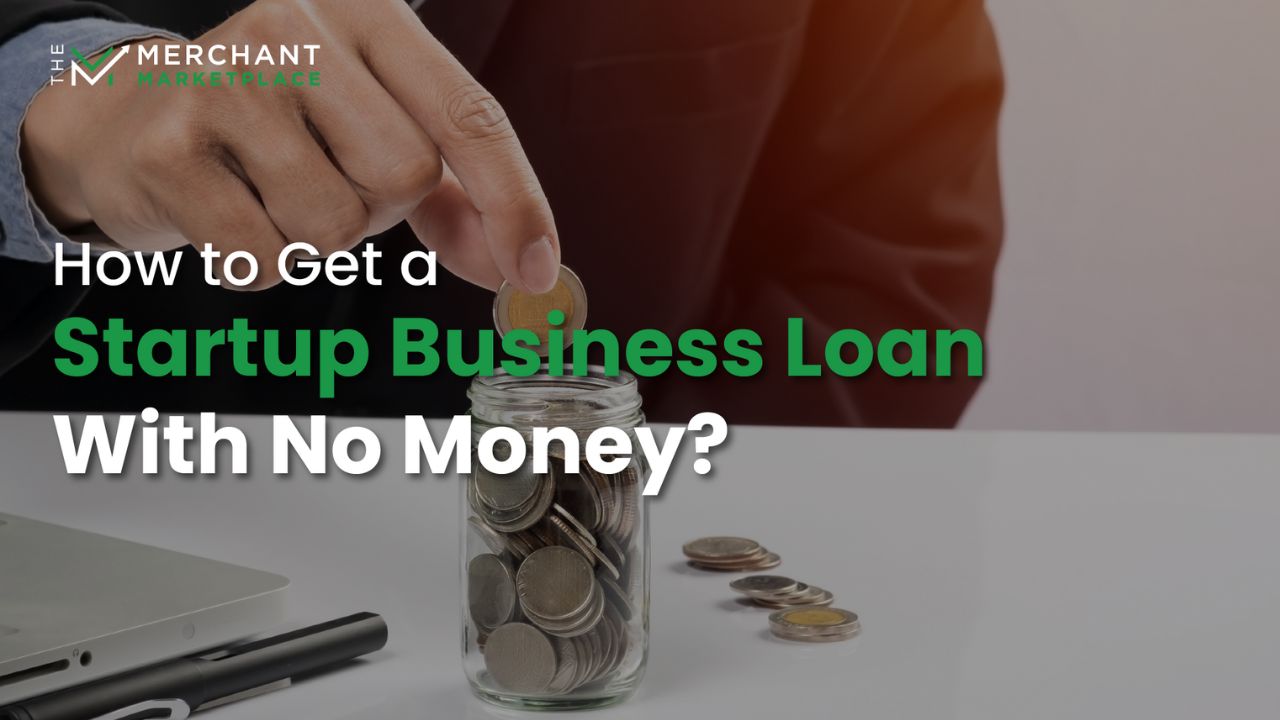Ever felt like you needed a million bucks to start a business? You’re not alone. Many dreamers are trapped in a cycle of ‘no money, no business, no money.’ But what if we tell you there’s a way out!
A 2024 Shopify survey found that small business owners usually drop about $40,000 in their first year. Your startup costs will hinge on things like what kind of business you’re in, where you’re located, and how big you’re aiming to go. But one thing’s for sure: you’re going to need some cash to get your dream up and running.
In this blog, we’ll help you with securing a startup loan, even if your bank account is as dry as a desert. We’re talking about actionable steps, real-world advice, and a roadmap to turn your entrepreneurial dreams into reality.
What is a Startup Business Loan?

A startup business loan is a type of financing designed to help new businesses get off the ground. It provides capital for essential expenses like equipment, inventory, and marketing. Lenders offer various loan amounts, interest rates, and repayment terms. Collateral may be required. By carefully considering your business’s needs and comparing different lenders, you can find the most suitable startup business loan to support your growth.
Types of Startup Business Loans:
If your business is low on funds and traditional term loans or SBA loans seem out of reach, there are several alternative financing options you can explore. Let’s dive into the different types of loans available.
Merchant Cash Advances (MCA)
MCAs provide quick cash by borrowing against future sales. Repayments are a percentage of daily sales, offering flexibility for fluctuating revenue. They don’t require collateral or a strong credit history but come with higher fees and interest rates.
Microloans
Microloans, ranging from $500 to $50,000, are perfect for startups needing small capital infusions. They’re easier to get than traditional loans but might require collateral or personal guarantees. Interest rates are manageable, supporting early-stage businesses.
Business Credit Cards
A business line of credit provides flexible funds up to a set limit. You pay interest only on what you use, and funds are available again once repaid. Ideal for managing day-to-day expenses and unexpected costs.
Invoice Financing
Borrow against unpaid invoices to manage cash flow. Options include factoring (selling invoices at a discount) or invoice discounting (using invoices as collateral for a line of credit). This helps alleviate financial pressure while waiting for customer payments.
Crowdfunding
Raise capital from the public by presenting your business idea on crowdfunding platforms. Small contributions from many backers can add up, validating your idea and raising funds without equity loss or debt. Effective marketing can turn campaigns into significant capital sources.
These alternative financing options offer fast access to capital with flexible terms, catering to businesses that might not qualify for traditional loans.
How to Get a Startup Business Loan with No Money: 7 Proven Ways
Securing a startup business loan without any initial capital may seem challenging, but it’s not impossible. Here are seven proven ways to Get a Startup Business Loan with No Money:
1]. Merchant Cash Advances (MCA)
Merchant Marketplace (MMP) offers Merchant Cash Advance (MCA) which involves borrowing against your future sales or credit card transactions. It provides quick access to cash, making it an attractive option for startups in need of immediate funding.
Lenders advance a lump sum of money based on the expected future sales of your business.
Repayment is typically structured as a percentage of daily credit card transactions or a fixed daily or weekly amount. This arrangement means that during slow sales periods, the repayment amount adjusts accordingly. The lender often requires a daily or weekly review of sales to calculate the repayment amount.
Steps to Apply:
- Provide business details, including revenue history.
- A lender like MMP advances a lump sum based on future sales.
- Repayments are made through a percentage of daily sales or a fixed amount.
In Chicago, a restaurant needed $75,000 for a crucial renovation. Using a Merchant Cash Advance, they upgraded their kitchen and expanded seating. Within six months, daily sales jumped 30%, adding $100,000 to their annual profit. This MCA turned a pressing need into a significant business boost.
Ready to get started? Explore our Merchant Cash Advance options today!
2]. Crowdfunding
Crowdfunding involves raising small amounts of money from a large number of people, usually through an online campaign. This method can be a great way to generate funds and validate your business idea.
You pitch your business idea on a crowdfunding site, setting a funding goal and offering rewards or incentives to backers.
If the goal is reached, you receive the funds. Crowdfunding campaigns often include various reward tiers or early access to products to encourage contributions. Success relies heavily on marketing efforts to attract backers and maintain engagement throughout the campaign.
Steps to Apply:
- Pitch your business on a crowdfunding platform.
- Set a funding goal and offer incentives or rewards to backers.
- Promote the campaign to attract contributions.
In the past year, over 6.4 million crowdfunding campaigns were launched, and this number is projected to nearly double within the next four years. The crowdfunding industry is expected to reach a remarkable $300 billion by 2030.
3]. Business Credit Cards
Business credit cards offer a flexible revolving line of credit to cover various business expenses. They can be a useful tool for managing short-term cash flow needs, providing a credit limit based on your business’s creditworthiness. Timely payments on a business credit card can help build your business credit history and may offer rewards, cash back, or other valuable perks.
Steps to Apply:
- Apply through a financial institution like Merchant Marketplace(MMP), demonstrating your business’s creditworthiness.
- Receive a credit limit, which you can use as needed for expenses.
- Repay what you use to free up your credit limit again.
Merchant Marketplace provides tailored business credit cards designed to meet your startup’s unique needs. For instance, a startup might use a $15,000 limit card to handle unexpected costs, leveraging the card’s flexibility while benefiting from potential rewards and cash back options. Responsible use can contribute positively to your business credit profile and overall financial health.
4]. Angel Investors
Angel investors are wealthy individuals who provide capital to startups in exchange for equity or convertible debt. They often seek innovative ideas with significant growth potential and offer mentorship and connections in addition to funding.
To attract angel investors, you’ll need to present a compelling business plan and demonstrate a clear path to profitability. In exchange, you may offer a percentage of equity or convertible notes that can later be converted into equity. Angel investors typically look for startups with high growth potential and may take an active role in guiding the business. Negotiations often include discussions on valuation, equity share, and investor involvement in the company.
Steps to Apply:
- Create a compelling business plan.
- Demonstrate growth potential to attract investors.
- Negotiate terms, such as equity or convertible debt.
An angel investor might invest $100,000 in exchange for a 20% equity stake in your company. They could also offer advice and connections that help accelerate your growth.
5]. Microloans
Microloans are small loans typically offered by non-profit organizations, government agencies, or community-based lenders. They are designed to help startups and small businesses that may not qualify for traditional loans.
Microloans can range from a few hundred dollars to up to $50,000. The application process usually involves presenting a detailed business plan and demonstrating the ability to repay the loan.
Microloans often have more flexible terms and lower interest rates compared to traditional loans, and the application process may focus more on the potential impact of your business on the community rather than solely on credit history. This makes them suitable for businesses with limited access to conventional funding sources.
Steps to Apply:
- Submit a business plan.
- Provide financial and repayment ability.
- Secure collateral or a personal guarantee.
A startup might secure a $10,000 microloan from a community development organization to purchase equipment and cover initial operating expenses.
6]. Asset-Based Financing
Asset-based financing allows businesses to secure loans by using their valuable assets as collateral. This includes inventory, machinery, accounts receivable, and real estate. Since the loan is secured by assets, it often comes with more lenient lending standards, making it a great option for startups struggling to qualify for traditional loans.
Steps to Apply:
- Identify and present valuable assets as collateral.
- Have the assets appraised to determine the loan amount.
- Negotiate terms with the lender based on the asset value.
Asset-based financing involves selling outstanding invoices to a third party for a lump sum, typically between 80% to 90% of the invoice value. It provides quick working capital, bypassing strict credit score requirements.
A Texas-based startup faced cash flow issues and factored $150,000 in invoices. They received $127,500 upfront, which allowed them to boost production and secure new contracts. Within three months, their revenue increased by $500,000, demonstrating the impact of effective asset-based financing.
7]. Grants
Grants are funds provided by governments, non-profits, or private organizations that do not need to be repaid. They are often awarded based on specific criteria or for particular types of projects.
To apply for a grant, you typically need to submit a detailed proposal outlining your business plan, objectives, and how the grant will be used. Grants are competitive and require thorough documentation. The application process may involve detailed reports and presentations to demonstrate how the grant funds will contribute to the project’s success. Grants often come with specific conditions on how the funds should be used, and you must ensure compliance with these requirements.
Pros and Cons of Getting a Startup Business Loan with No Initial Investment
Pros:
- Access to Startup Funding: Startup loans provide crucial capital to help you enter the market strong, allowing you to get your business off the ground, sustain operations, and support growth.
- No Revenue Requirements: These loans don’t require long business histories or high revenue, making them accessible even if you’re just starting out.
- Maintained Ownership: Unlike equity financing, startup loans allow you to retain full ownership and control of your business while still securing necessary funds.
- Building Business Credit: Timely repayment of startup loans helps establish and build your business credit, which can pave the way for more competitive financing options in the future.
Cons:
- Personal Credit Dependency: If your business lacks its own credit history, you might need good personal credit to secure a loan.
- Collateral and Guarantees: Startup loans often require a personal guarantee or collateral, risking personal assets if you fail to repay.
- High Costs: These loans may come with high fees and APRs, making them an expensive option, especially for low-revenue or newer businesses.
- Risk of Expensive Terms: Due to the perceived risk, startup loans often have higher interest rates and fees, which can make financing more costly.
Frequently Asked Questions (FAQs)
1]. How can I get a startup loan with no revenue?
A startup loan without revenue is possible, but it typically requires a strong business plan and other compensating factors. Lenders will look at your business idea, personal credit score, and potential for future revenue. Offering collateral or a personal guarantee can also help strengthen your application.
2]. What types of collateral can I use for a startup loan?
Collateral for a startup loan can include personal assets like real estate, vehicles, or equipment. Business assets, such as inventory or accounts receivable, might also be used. The more valuable and liquid your collateral, the better your chances of securing the loan.
3]. Can I get a startup loan if I have bad credit?
Getting a startup loan with bad credit is challenging but not impossible. Lenders may consider other factors such as your business plan, potential for revenue, and personal assets. Offering a personal guarantee or collateral can also improve your chances of approval.
4]. What should be included in a business plan for a startup loan?
A strong business plan should include an overview of your business model, target market, competitive analysis, financial projections, and a detailed repayment strategy. This plan helps lenders understand your business’s potential and how you intend to use and repay the loan.
Summary
Securing a startup loan without initial capital requires careful planning and perseverance. While it’s challenging, it’s not impossible. A well-crafted business plan is essential to convince lenders of your venture’s viability. You may also need to personally guarantee the loan or provide collateral.
Thoroughly review loan applications to ensure the terms are favorable. If the funding falls short of your needs, consider combining multiple sources like MCA and Business credit cards. With a solid strategy, in-depth research, and unwavering determination, you can increase your chances of securing the necessary funding for your startup.




